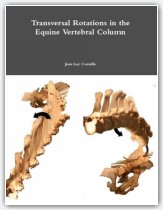Review of “Transversal Rotations in the Equine Vertebral Column
Review of “Transversal Rotations in the Equine Vertebral Column
by
Jean Luc Cornille
Reviewed by Susan Hopf
To fully understand the intricacy of this amazing book this review begins by quoting the last paragraph:
“The art of riding might be limited to the rider’s skill but the art of training demands a deep understanding of the horse’s physiology. Creating an elegant and sound movement is an art that does not differ from the art of painting or sculpting.” Jean Luc Cornille
“The ability of the artist to express the beauty of the human form is predicated on a profound study of the science of anatomy.” Leonardo da Vinci
The implications contained within Jean Luc Cornille’s book “Transversal Rotations in the Equine Vertebral Column” are vast and poignant. No longer is there any reason to ride your horse without a clear understanding of their physiological abilities and limitations. Old masters would have given up an arm to have such knowledge at their fingertips and given their genius with horses need not have been that concerned. Riders of less than genius ability and trainers that work from old ideas, whether good or bad but are now obsolete, are among those that should benefit from this clearly illustrated, science-based text – those that teach must, by the very nature of such a proclivity, stay well informed in order to impart the most accurate information possible. Those that care enough to search for answers for the betterment of the horse will not be disappointed – this book answers many questions with regard to the bending of the horse, riding the shoulder-in and rider position in relation to both. The gold standard of equine exercises has finally been defined from the perspective of the (physical) horse.
Despite this being the most up to date text on the physiology & biomechanics of the horse’s spine the information is easily understood. Armed with a good equine anatomy book (something that all good trainers should be familiar with and all riders should be interested in) the concepts are presented with precise and well-researched language. Even with the obvious French (accent) that accompanies all of Cornille’s writing the complexities of equine locomotion is unraveled. You will understand more of what you feel, why you are feeling such and how your position impacts the horse.
As we read through the technical and sometimes witty explanations we begin to understand that bending (or rotation) of the various sections of the equine vertebral column creates forces on the rest of the horse’s body. Very subtle shifts of the rider’s seat, shoulders, hips, etc creates opposing forces in this receptive spine and sends messages along many pathways to the very active equine brain. However we also learn that this spine is not very flexible at all and that using the inside leg and the outside rein (among other age-old ideas) is not the correct approach as it creates inverted rotation – shifting the horse’s body into counterproductive and damaging positions.
Once read this will (should) change the way you ride your horse. No more should we find it necessary to restrict, constrict, demand or otherwise crudely ask our horses to move in a distorted frame. The ideas are simple – learn how your horse moves from a scientifically sound aspect and they will give you all you ask for and more. You can ride secure in the knowledge that you are no longer creating problems for your four-legged partners and are, instead, on the path of producing a sound and elegant mover for the life of the horse.
Review of my personal copy of the book

Buy The Book


